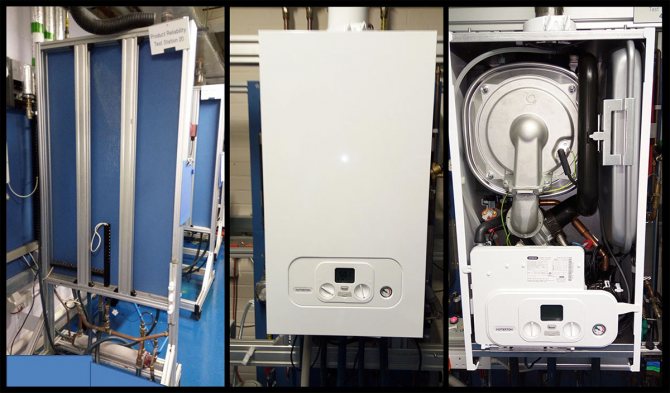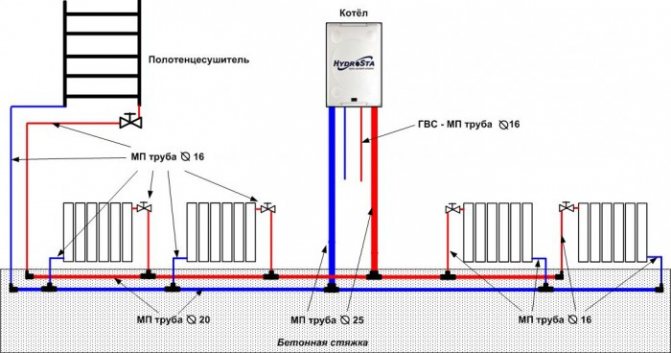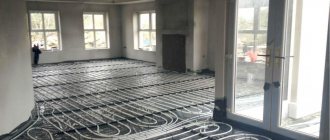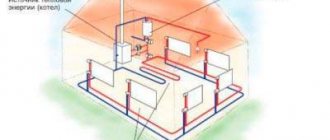The constant rise in utility bills does not suit many owners of urban dwellings. At some point, some of them begin to think about creating individual heating in an apartment building. This process has many nuances that you should learn about before starting the procedure.
Pay only for yourself in an apartment building
general information
The creation of an individual heating system in an apartment assumes that the owner refuses to use traditional heat supply. During this work, pipes and radiators are dismantled, instead of them new batteries and lines are installed, connected to the heating installation.
Recently, electric boilers and gas-fired equipment have been increasingly used in apartments. Such devices function according to a simple principle: they increase the temperature of the water and ensure its constant circulation in the system, due to which the city apartment is heated. Gas models can be single or double circuit. The former are used exclusively for heating rooms, the latter additionally provide the apartment with hot water.
In this video, we will consider examples of heating in an apartment building:
How does the installation work?
The craftsmen begin the installation of gas heating in the apartment with the disassembly and disposal of the old system. For this, in addition to new equipment, special tools are required, which are equipped with experienced specialists. After that, the workers will start installing the boiler. In this case, the craftsmen listen to the wishes of the client about the location and height of the device. This will allow you to fit the boiler into your interior as beautifully as possible.
The next stage is the installation of a gas heating system, new pipes and a radiator. Upon completion of the work, the masters will definitely check the high-quality operation of the equipment and the reliability of the entire system. They will test the heating of the entire house, the rate of heating of the water and the overall tightness of the system. The last will be a gas meter for accurate calculation of the fuel used and greater savings.
Varieties of devices
The variety of boilers for heating today is simply amazing. These units can be wall-mounted or floor-mounted. The first ones are the most in demand. Experts consider their main advantages to be compact size and attractive price. The floor-standing ones are also not devoid of advantages, which include high power and the ability to operate for a long time.
Along with devices that require “blue” fuel for operation, electric boilers are common. The main positive aspects when using them are affordable price and high level of security. The installation of such devices is permissible in absolutely any room in the apartment.
But if the house has old wiring, then the placement of such equipment will not be the best solution, since the risk of constant knocking out of traffic jams increases.
Having chosen a gas boiler as a device for an autonomous system, you need to prepare for big expenses. Installation of such devices is expensive. However, they delight the owner with a long service life and quickly pay off. The thing is that “blue” fuel is cheaper than electric energy.
When looking for suitable equipment, it is necessary to build on the size of the room and take into account a number of other conditions. Selection of installation for heating - a responsible task, so you should not be frivolous about buying such a device. It is important that the model has sufficient power to create a warm atmosphere in the home. When calculating this parameter, one should be guided by the following norm: 1 kW of heating boiler power creates a comfortable temperature for 10 m². To determine exactly what capacity of the installation will be the most suitable, you just need to divide the area of the apartment by 10.
Reasons for the transition
Already today, it can be stated that individual heating in apartment buildings is popular. There are several reasons at once that explain this fact. The main ones are:
- Lack of dependence on the air temperature outside. The owner does not need to wait until, according to the management company, it is cold enough outside to turn on the heating.
- The ability to quickly create a comfortable microclimate. If the owner, being in the apartment, experiences discomfort due to the low temperature, then it is enough for him to turn on the heating system to make it warmer.
- The ability to independently change the heating mode in the rooms. If the wiring of the networks in the house is installed incorrectly, then in winter the owner may feel a strong cold. Even if you contact the management company, the problem cannot be solved. Just because of one person, the heating system of the whole house or the wiring at the entrance will not change.
When creating an autonomous heating system in an apartment, significant money is saved. The owner of the city dwelling pays only for the heat he received.
Advantages and disadvantages
To make it clear whether it makes sense to install autonomous heating in an apartment, you need to find out about its main pros and cons. Having received this information, the owner will be able to make the right decision. Among the main advantages of individual heating can be attributed:
- Choice of radiators... For the device of an individual system, the owner can use absolutely any batteries, since there is no likelihood of a water hammer.
- Hot water is available even in summer... In the hot season, utilities often carry out repairs and turn it off. If the apartment has autonomous heating, then the owner of the apartment will not experience any inconvenience even during the hot season.
It is interesting: what heating radiators are better to choose.
Listing the disadvantages of such systems, it is necessary to highlight the main one - the high cost of equipment.
Along with this, the installation of a new heating circuit requires certain expenses from the owner. Often, when creating an autonomous system, there is a need for an exhaust duct.
Registration procedure
Before starting the installation of equipment, it is necessary to draw up a project for autonomous heating. Often, gas units are used as the main heating installation for such systems. The owner needs to contact the supplier of the "blue" fuel so that the heating scheme is drawn up correctly. The organization's specialists will determine the best option for autonomous heating, taking into account specific technical conditions.
The most significant point is the pressure level in the gas pipeline. If it is insufficient and does not allow to ensure the normal operation of the installation, then you can forget about the creation of gas heating in the apartment. Then you will have to consider the option with a heating device with a different coolant. Alternatively, you can take a closer look at the scheme with an electric boiler or do it easier by installing a "warm floor" in the apartment.
It is interesting: what type of underfloor heating is better to choose.
Before you go to the gas company, you need to collect a certain list of documents. The owner will need to provide:
- Technical passport for the apartment. This document should contain information that the dwelling is disconnected from the centralized heating supply.
- Passport and TIN.
- A copy of the equipment passport, as well as instructions for its installation.
- Paid invoice for the services of a gas company for the preparation of an individual heating system.
When permission is received from the gas supplier, you can proceed to the creation of individual heating in your home.
The legislation of the Russian Federation clearly spelled out important points regarding the arrangement of autonomous gas heating. The boiler must be equipped with a closed combustion chamber and have well-functioning ways of removing carbon monoxide. If this condition is not met, then a ban will be imposed on the installation of a device for heating an apartment.
Obtaining a permit permit for individual heating in an apartment 2020
The procedure for arranging autonomous heating is regulated by the norms of the Housing Code (Articles 26 and 27) and Federal Law No. 190 of July 27, 2010 "On Heat Supply". In accordance with these documents, in order to install an autonomous heating system in your apartment, you must obtain the consent of local authorities.
It is issued by an interdepartmental commission responsible for the use of the housing stock. A complete package of documents must be submitted to this authority. Authorized employees will study the request, assess the risks of disconnecting a particular apartment from the heating network and make a decision. The officials are given a month and a half for all this. The final document drawn up by the commission is issued to the applicant within three days after the decision is made.
Preparation of documents also takes a lot of time. Its features depend on the type of heating chosen by the applicant - electric or gas.

In the first case, it is enough to write an application for disconnection from the central heating supply to the city heating networks, coordinate your actions with the administration and apply for the installation of an autonomous heating system.
To install a gas boiler, residents need:
- Apply to the gas service.
- Obtain from the fire inspectorate a document on the correct operation of the chimney and ventilation.
- Obtain written consent from neighbors for the installation of autonomous heating.
- Obtain permission from heating networks to draw up and approve a plan for an autonomous heating system.
Now you can start dismantling the old equipment and installing the new one. The right to connect an individual heat source is granted only to specialists of gas supply organizations. Self-assembly is life-threatening, and neighbors or regulatory authorities can sue. In total, it takes from three months to six months to obtain permits and install.
Disconnection of district heating
To transfer an apartment to autonomous heating, you must first apply for a refusal to use district heating. When a positive decision is received, you can proceed to installing a boiler and other related equipment in the apartment.
To disconnect an apartment from central heating, you need to find out who is responsible for the pipes and radiators. If they are owned by the owners of the house, then permission should be obtained from the neighbors. If the apartment building is served by special services, then an application should be submitted with a request to disconnect from the heat supply networks.
You must contact your home service company and get a permit. The document must contain the approved scheme and there must be permission to transfer the apartment to individual heating. Only after that you can proceed directly to dismantling the old system and installing an individual heating scheme for the apartment. It takes a lot of time to switch from one to the other.The experience of many apartment owners suggests that this takes 3-6 months.
To each his own
The introduction of new systems in housing and communal services is prompted not only by the increase in cost, but also by other circumstances. In Smolensk, for example, the last two winters were remembered by constant accidents on heating systems, due to which thousands of people were deprived of hot water and heat in the cold. It is impossible to put worn-out highways in order in a short time. Therefore, not only citizens, but also local authorities are interested in individual heating of housing. Another significant reason was the transition to heating standards tariffed by number of storeys, in connection with which in one- and two-storey houses built in 1999 and older, the consumption standard is doubled. In the Kaluga region, for example, 1,600 such buildings were counted. In seven districts - Zhizdrinsky, Kuibyshevsky, Baryatinsky, Khvastovichsky, Meshchovsky, Mosalsky and Ulyanovsky - the transfer to apartment heating was already completed last year, and this work continues.
The predecessors of modern individual heating systems can be considered huge, noisy and heavy boilers AOGV, which were already installed in low-rise buildings in the post-war period and provided residents with not only heat, but also hot water. Then individual flow heaters appeared - "gas water heaters", which aroused envy among neighbors, since they allowed their happy owners not to depend on hot water outages. In the end, engineers have created double-circuit gas boilers that do not take up much space even in a small kitchen and successfully cope with heating and hot water supply for an individual apartment. Having appreciated their advantages, many managed to independently mount such systems in their own apartments, disconnecting from centralized heating, but since 2011 this operation has become almost impossible.
“The federal law on heat supply did not ban, but limited and streamlined the transfer of apartments to individual heating,” said Sergei Stoyanov, deputy general director and chief engineer of the Smolensk gas distribution company. - It seems to me to be correct, since such actions, among other things, were unfair in relation to the neighbors.
- You installed an individual heating system in your apartment, brought out the chimney through the wall, and all poisonous combustion products began to fall into the open vents, windows and balconies of other residents. In addition, stairwells and neighbors' apartments are heated in old houses, which means that even with the individual heating system turned off, the temperature in your apartment is unlikely to drop below 10 degrees. That is, you still use district heating! And I agree with the current approach: if there is a desire to switch to individual heating, let's transfer the whole house, - says Sergei Stoyanov.
The process of transferring a residential building to individual heating is not easy and costly. A serious problem, for example, can arise from the throughput of gas pipes. Since the apartments will need to be supplied with much more gas, it will be necessary to change the risers designed only for gas stoves, and even the supply gas pipeline. The problem of smoke extraction is even more difficult. According to federal law, the chimney must rise above the level of the building, and if it is not initially provided, it will have to be installed half a meter from the facade, attaching the corresponding pipes from the boilers in the apartments to it. This is, to put it mildly, ugly. In addition, air must enter the boiler, which means another hole in the wall is required.
The flaws in the centralized heat supply system will affect the quality of life of the townspeople for a long time.
- There are problems with architectural monuments, - admits the Deputy Minister of Construction and Housing and Communal Services of the Kaluga Region Ruslan Mailov. - It is impossible to pass an architectural examination and obtain permits for attached gas ducts and the necessary measures to change the facade of the building. Now we are trying to convince the defenders of the monuments that we have to make sacrifices for the sake of the population.
Kaluga officials say that 330 of the 1,600 houses that need to be converted to individual heating in the region will fail. This is just about the monuments of architecture and dilapidated housing subject to resettlement. In Smolensk, such systems are also being introduced in old houses, albeit not as actively as in their neighbors. Almost all apartment buildings in the regional centers of Rudnya and Demidov, eight in Khislavichi, two five-story buildings in Yershichi, four two-story buildings in Katyn and so on, have been transferred to "individual" housing. Modernization is carried out in various ways: somewhere the tenants have the means, and they managed to come to an agreement with each other, and somewhere the local authorities are involved in the process.
The most difficult thing, as experts say, is to come to an agreement: often there are one or two residents in the house who flatly refuse individual heating, for example, due to lack of money. This process is really not cheap - the cost of the transition is up to 100 thousand rubles per apartment in an old house. This amount includes the cost of the boiler - about 40 thousand, the project and installation - about 15. Plus, it is often necessary to change the heating system, since it is not recommended to leave the old cast-iron radiators in this case. Not every family is capable of "pulling" such expenses. And the question arises: are other participants in the heat supply market interested in a massive transition to individual heating?
- Local authorities - yes, - Sergei Stoyanov is sure. “The efficiency of the municipal heat supply company will be important for them for many years to come. By closing the unprofitable boiler houses, which are now on its balance sheet, they thereby contribute to the improvement of the municipal unitary enterprise, increasing its investment attractiveness. But there is no money, and it is almost impossible to find an investor.
Last year, due to the bankruptcy of one of the industrial enterprises in Smolensk, there was a threat of disruption of the heating season on Narvskaya Street. The building of the factory boiler house, to which the residential buildings were also connected, fell into the bankruptcy estate. The city authorities managed to find an interested investor who installed a modern modular boiler house in the microdistrict, but it is already clear that the company will not develop this business - it is too difficult to receive payment for the supplied heat in Smolensk and the payback period is too long. If the monopolist, the guaranteeing supplier, constantly complains about this, it is clear that the owner of one small boiler house is in even worse shape. In this sense, the transition to individual heating would be a real gift for local authorities: no responsibility for accidents and shutdowns, no problem of non-payments, no subsidies from the budget.
- Heat suppliers, of course, will react negatively to the more or less significant transition of customers to individual heating, - says Sergei Stoyanov. - As for gas suppliers, it is hardly worth talking about some kind of acquisition, some kind of benefit, unless the number of customers in need of maintenance and repair of equipment will increase. I don't think the gas holding will notice this process: the gas that was previously burned at the CHP plant will be burned in apartments.
Experts are sure that a large-scale transfer of housing to individual heating is possible only within the framework of the federal program - roughly the way, until recently, the overhaul of apartment buildings was carried out.Energy supplying organizations are actually not interested in this, local and regional authorities have neither the money nor the political will to turn this work from a punctual to a systemic one. This means that the flaws in the centralized heat supply system will affect the quality of life of the townspeople for a long time to come.
Equipment selection
To create an efficient and trouble-free system, it is necessary to properly approach the problem of equipment selection. The best option is to use a gas installation. It is optimal if it has a two-circuit design, but a single-circuit model can also be dispensed with. The choice in her favor should be made only if there are no interruptions in the supply of hot water in the apartment.
Using gas equipment as the main element of the heating system, you can significantly reduce heating costs.
However, this will require the installation of a two-two-rate counter. At the same time, it is desirable that new wiring be laid in the apartment. It is best if it is copper.
Installation features
If desired, the installation of the heating system can be done by hand. Laying pipes and installing heating radiators are not super complicated activities. The help of professionals will be required when you need to make a gas branch, connect and start the boiler. Upon completion of the installation, they will check that the system is working correctly.
It is rather difficult to talk about the average cost of such work, since there are nuances in the creation of individual heating. Many factors form the final amount. The cost of work is influenced by the size of the apartment, the brand of the device and its functions. Also important is the material from which the pipes are made and the prices of individual specialists. But even with serious expenses, the owner pays for the money spent on the creation of such a system in a short time.
Individual gas heating in an apartment building is the right choice for many people who do not want to live without hot water for several weeks every summer.
With its help, you can provide a comfortable microclimate in your home at any time. When choosing a boiler, special attention should be paid to its capacity, which depends on the area of the dwelling.
Only professionals can correctly install the device and carry out the adjustment of its operation. This will require a certain amount of money. But upon their completion, the owner will have at his disposal an economical and smoothly functioning system. It will provide warmth in a city dwelling, and during operation it will not require much attention.
What to prepare for? Educational program for beginners
If you are not satisfied with cold batteries, when it is already cold outside, and the heating season has not yet begun, if you do not understand why the batteries are "ice-cold" in one room, and in another they are hot so that you cannot put a hand on their surface if there are interruptions Since heating and hot water have become more the rule than the exception, experts recommend installing autonomous gas heating in the apartment, if, of course, the apartment is gasified.
If you decide to install "autonomous" in your own apartment, then you need to be prepared for the following:
- Enough tough opposition from your heat supply organization.
- The non-acceptance of your decision by the co-owners of the apartment building, in other words, by your neighbors.
- Legislative denials and bureaucratic delays in the gas, fire service, as well as in the authorities for the protection of architectural monuments.
- Complete replacement of intra-apartment piping.
- Financial costs for the creation of a project, the purchase and installation of equipment.
In fact, opponents of individual heating have quite good reasons for this. After disconnecting any room of a residential building from centralized heating, the heat engineers have to rebalance the entire heating system of the house.In addition, the rejection of district heating means the termination of financing for the heat supply organization. Within the framework of one apartment it is imperceptible, but with a massive transition to "autonomous" - this is the bankruptcy of a huge organization.
Individual gas heating in an apartment building requires a competent removal of the combustion products of the gas mixture. In houses with chimneys, this is not a problem. In modern buildings, a chimney is not provided, therefore, the exhaust gases are discharged into a separate ventilation branch or through a coaxial chimney, which is discharged through the load-bearing wall. With such a chimney, it is possible that carbon monoxide can enter neighboring apartments: in the first case, through the ventilation hole; in the second - through open vents and windows.
The decision to install an individual heating system is very good to initially discuss with a lawyer. The thing is that in some regions of Russia the creation of "autonomous" is prohibited by local legislative bodies.
There is another option for avoiding central heating, without delays and hassle - contacting an organization that sells equipment, installs and maintains individual heating systems. For some remuneration, these offices independently solve problems with permits, projects, within an acceptable time frame.














